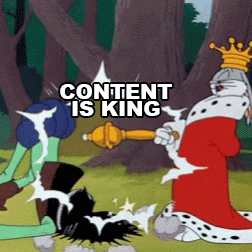Content creation is one of the most important parts of digital marketing. It helps your brand stay relevant, build credibility and create a recognizable voice. If you’re looking for inspiration on how to improve your content or want to get started with content creation, check out this in-depth guide on the content creation process.

What is content creation?
Content creation is the process of identifying ideas that will resonate with your target audience and building those ideas into tangible and valuable content in the form of blogs, articles, videos, graphics, and podcasts. The goal of content creation is to give your audience valuable information that can help them in solving their problems.
It’s important to understand that the term “content creation” can be used to describe both what you create (the actual content) and how you use it in order to achieve results. It might seem like they’re separate things, but they’re not: Your content should always be created with specific goals in mind, whether those are generating leads or increasing brand awareness—and then it needs to be planned out accordingly. In today’s digital world, we have more opportunities than ever before to consume information about our favorite brands; so if yours isn’t producing enough quality content on a regular basis, chances are its competitors will fill the void quickly just by keeping up with trends and staying ahead of the curve!
Why is content creation important?
Content creation is an indispensable tool to promote businesses. Content drives traffic to your website and provides the necessary information to persuade potential customers to buy your product or use your service. Content creation is so important and inseparable from your brand because;
- It’s a way to connect with your audience.
- It’s a way to build trust. Your audience will trust you more if they know that you’re putting out quality content that they resonate with and not just trying to sell them something.
- It’s a way to build authority in your field. If people are reading your blog posts or watching your videos, other professionals may look up to you as an expert on the topic of business or writing (and hopefully hire/consult with you!).
- Content creation is often used as part of branding efforts because it gives consumers insight into what makes each company unique while simultaneously helping businesses maintain awareness among potential customers over time.

Types of Content
- Blogs – Blogs are a great way to generate content and build connections with audiences. One technique we’ve found particularly effective is writing blog posts in the form of questions, answers, or statements. This is because your blog readers will be more likely to leave a comment if they feel like they’re contributing to the conversation. SEO-optimized content writing can also be utilized to reach a wider audience and build your brand.
- Video – Video is the most popular form of content, and it’s also the most effective. In fact, people who watch videos on social media are more likely to engage with a brand than those who don’t. Video is also the most engaging: people watch videos longer than they do any other type of content—it takes them twice as long to read an article than it does to watch a video.
Video is also the most shareable form of content (especially when you add in attention-grabbing thumbnail images). This means you can expect your videos to reach more people than any other type of content you create.
- Podcasts– The popularity of podcasts is constantly growing, as audiences are drawn more and more to the content they can consume on the go. Podcasting is not for every brand, however. If you do go down the podcast route, make sure you have something interesting to say and someone interesting to say it!
- Images – Images are an important part of the content creation process. They can help you keep your audience engaged and illustrate your point. Images can also create a mood, give the reader a sense of space and depth, or simply add interest to a webpage.
The most important thing to remember when creating images is that they should be relevant to the text around them. If they’re not, they’ll distract from what you’re trying to say instead of enhancing it.
The content creation process
Ideation
Great content starts with a great idea. The ideation process is the time to get creative—using what you know about your audience and your brand, think of ways to add value or provide useful information in a way that adds value (and hopefully makes people want to buy things)
Brainstorming is essential to this process. Brainstorming can be done alone or with a group. A group can be useful to bounce ideas around and elaborate on them, but either way, make sure you write everything down! It’s easy for ideas to get lost in a brainstorming scenario. Support your brainstorming sessions with research, before and after the fact!
If there’s one thing we learned from our experience, it’s that research is key. Research can take many forms depending on what kind of content creation method(s) you’re using—whether it be listening sessions or surveys—but regardless of how much time spent researching before writing something down will always pay off tremendously in terms of a quality finished product later on down the line.
Content planning and strategy
A content strategy is your road map to creating the right content at the right time. Content creation plans help you build a specific, measurable strategy that aligns with your goals and objectives.
Creation
Content creation is a process. This may seem like an obvious statement, but it’s important to recognize that content creation is not a one-off activity. It’s not as simple as sitting down and writing whatever comes to mind or filming your new product on your smartphone. Content creation requires time and effort, and originality, if you’re going to hold the attention of the user.
Content creation is a team effort. A good piece of content usually needs input from multiple people who have different perspectives on different aspects of the website’s target audience or business goals. Content creation also requires feedback loops throughout its lifecycle, so things can be tweaked along the way.
Revision- Revising your content is a great way to spot errors or potential for bettering the content. Consistently going back over your content, with buyer personas in mind will ensure your final piece of content is flawless.
Optimization
Optimizing content is a multi-step process that can be broken down into several stages:
- The first step is to choose the right tools for you or your team. There are plenty of options out there, but what matters most is finding the tool that fits your needs best. It’s important to consider things like price points, features, and integrations available so that you can build a strategy around these factors.
- The next step is understanding your audience. Who are they? What do they need from you? How can you solve those problems through content? These questions will guide the rest of this article because they’re vital components in any optimization strategy. This step is crucial for selecting the topics and keywords you’ll be creating content around and the formats you will use to reach your audience.
- Then comes figuring out what business goals are most important for each piece of content being created and measuring how well those goals are accomplished by every piece of content produced as part of an overall strategic plan built around those same criteria above (that includes everything from social media posts to email newsletters).
- Finally—and perhaps most importantly—you must look at how users interact with different types of content across multiple platforms (including web browsers), devices (smartphones included), or channels before deciding whether certain types should be eliminated because they’re not worth investing time into any more thanks mostly due their low engagement rates compared others which receive higher engagement rates thanks largely due their higher quality versus quantity ratio when it comes time.
Analyzing your content
Website analytics is the most important tool you can use to understand your website’s performance and how it’s affecting your business goals. You can use this data to optimize your existing content, create new content that suits the needs of your audience, and better understand what competitors are doing. Analytics tools track traffic sources (search engines or social media) so you know where people are coming from when they land on your site. You can also see how long visitors stay on the page before leaving or clicking off to another site altogether. This information will help you determine if there is something about the design of a specific page that turns people away from it quickly—you might need more images or illustrations for example, or maybe too much text makes them feel overwhelmed.

Content Creation Tools
Content creation can be a minefield, and while you might have a list packed with content ideas, you might not have the time or skill set needed to execute these ideas. We have reviewed a number of content creation tools and have compiled a list of the ones we believe will elevate your content.
- Canva – Canva is an online graphic design tool that allows you to create beautiful designs for any business, brand, or personal project. It’s free and easy to use, so if you’re interested in learning how Canva works, check out Canva’s tutorial for beginners
- Giphy– If you’re looking for a GIF, Giphy is the place to go. Giphy is a search engine for animated GIFs that lets you find the perfect one for your message. It has a huge library of GIFs, videos, memes, and stickers to add context to your content. You can also upload your own images or draw on them with text in the app before sharing them online. But what really makes Giphy stand out is its free API (application programming interface) that lets developers integrate Giphy’s tools into any website or app so users can search through GIFs right there on the page they’re visiting instead of having to click through an external site like Twitter or Pinterest just to use it as an embed code (which isn’t always ideal).
- Vidyard – Vidyard is a video marketing platform that helps you create, manage and optimize your video content. Vidyard’s powerful cloud-based software suite allows you to easily manage all of your videos across multiple channels.
- SurveyMonkey – SurveyMonkey is a web-based tool for creating surveys, questionnaires, and polls. It offers free plans that are easily accessible to the public, as well as paid plans with more advanced features. SurveyMonkey can be harnessed to gather the information that can be repurposed for content or to gather information on how audiences perceive your content.
- Google Trends– Google Trends offers a wealth of information that can help you create content that meets your audience’s needs. Take advantage of Google Trends’ data to write headlines and create content that is likely to be shared amongst your audience.
- Trello– Trello is a collaboration tool that organizes your projects into boards. With Trello, you can manage workflow, create and assign tasks, track progress, and identify roadblocks at a glance. Trello is particularly useful for managing content creation processes, as it includes project cards. Each project card lists the actions you can take on the item, such as updating due dates, adding attachments, etc, which is particularly useful with complex content.
- Content writers – Finally, you’ll want to have a crafty and skilled team of content writers to help you during the content creation process. Investing in professional content writing services can help you save time and effort during content creation and achieve better results from your content marketing campaign.
Final Thoughts
Content creation is a process, not a final destination. It’s about understanding your audience and getting them to engage with your content, whether that means sharing it or just reading it. Content marketing is about creating content for every stage of the buyer’s journey. It’s about setting goals and managing expectations. In a world where information is everywhere, and content is not only accessible but unavoidable, it’s essential that you create something worthwhile. It takes time, but if you do it right, it can be very rewarding!
